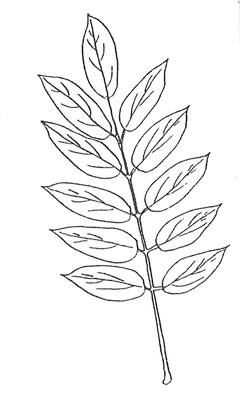Sophora japonica (so-for’-a ja-pon’-i-ka)
Family: Fabaceae, Pea
Key Steps
- 1b – Alternate leaf arrangement — go to 18
- 18b – Leaf compound — go to 58
- 58b – More than 3 leaflets — go to 59
- 59a – Entire or very finely serrate leaflet margins — go to 60
- 60b – Thornless — go to 62
- 62b – Leaflets obviously pointed at tips — go to 63
- 63a – Pinnately compound — Japanese Pagoda Tree
- 62b – Leaflets obviously pointed at tips — go to 63
- 60b – Thornless — go to 62
- 59a – Entire or very finely serrate leaflet margins — go to 60
- 58b – More than 3 leaflets — go to 59
- 18b – Leaf compound — go to 58
Description
 Leaf: Oddly pinnate, 7-17 leaflets, each 1-2 inches long, pointed tip, smooth margin. Shiny green above, slightly hairy beneath. Swollen base of petiole encloses bud. Leaf is 6-10 inches long.
Leaf: Oddly pinnate, 7-17 leaflets, each 1-2 inches long, pointed tip, smooth margin. Shiny green above, slightly hairy beneath. Swollen base of petiole encloses bud. Leaf is 6-10 inches long.
Bud: Blackish, woolly, small. Concealed by leaf scar. Unstalked. True terminal bud absent.
Leaf Scar: Raised, V-shaped, 3 bundle scars.
Stem: Slender, smooth. Green on young trees. Gray lenticels. Protruding nodes.
Pith: Solid, green.
Flower: Creamy white, 6-12 inches long, terminal panicles. Blooms in summer. Fragrant.
Fruit: Bright greenish-yellow pod, turning brown. 2-4 inches long. 1-6 seeds. Pod persists.
Habit: Large shade trees. Broad, round crown. To 40 feet tall.
Culture: Adapts to alkaline and saline soils. Moderate moisture requirement.
Resources




